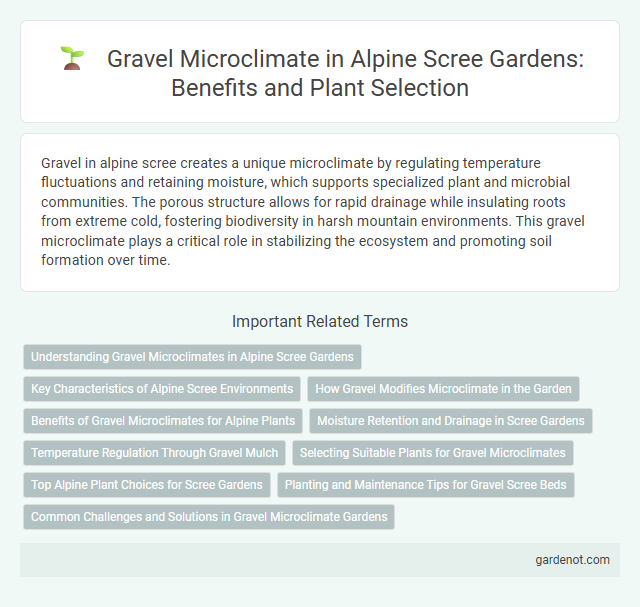Gravel in alpine scree creates a unique microclimate by regulating temperature fluctuations and retaining moisture, which supports specialized plant and microbial communities. The porous structure allows for rapid drainage while insulating roots from extreme cold, fostering biodiversity in harsh mountain environments. This gravel microclimate plays a critical role in stabilizing the ecosystem and promoting soil formation over time.
Understanding Gravel Microclimates in Alpine Scree Gardens
Gravel microclimates in alpine scree gardens create unique temperature and moisture conditions that influence plant survival and growth. The porous structure of gravel allows for excellent drainage and rapid temperature fluctuations, which help mimic natural alpine environments. Understanding these microclimate dynamics is essential for selecting suitable alpine species and ensuring their resilience in scree garden cultivation.
Key Characteristics of Alpine Scree Environments
Alpine scree environments feature highly porous surfaces composed of loose gravel and fragmented rock, which facilitate rapid drainage and reduce soil moisture retention. The gravel microclimate creates temperature fluctuations, insulating roots during cold periods while promoting rapid warming in sunlight, essential for the survival of specialized alpine flora. These conditions foster unique ecological niches with limited competition and high exposure to wind and solar radiation.
How Gravel Modifies Microclimate in the Garden
Gravel influences the garden microclimate by regulating soil temperature through its high thermal mass, absorbing heat during the day and releasing it at night, which reduces temperature fluctuations. It enhances soil drainage and aeration, preventing waterlogging and promoting healthy root development for alpine scree plants adapted to well-drained conditions. The reflective qualities of gravel also increase light availability to low-growing vegetation, fostering a microenvironment that supports diverse alpine flora.
Benefits of Gravel Microclimates for Alpine Plants
Gravel microclimates in alpine scree provide essential temperature regulation and moisture retention for plants, creating a stable environment in otherwise harsh conditions. These microhabitats reduce temperature extremes by insulating roots from frost and heat while enhancing water availability during dry periods. This unique combination supports the survival and growth of specialized alpine flora adapted to high-altitude ecosystems.
Moisture Retention and Drainage in Scree Gardens
Moisture retention in alpine scree is critical for sustaining plant life, as the loose gravel allows for rapid water infiltration while preventing waterlogging. The coarse texture of scree facilitates efficient drainage, minimizing root rot and promoting healthy growth in scree gardens. Optimal balance between moisture retention and drainage supports resilient alpine flora adapted to harsh environmental conditions.
Temperature Regulation Through Gravel Mulch
Gravel mulch in alpine scree habitats plays a crucial role in temperature regulation by absorbing heat during the day and slowly releasing it at night, creating a stable microclimate for plants and soil organisms. This thermal buffering effect helps protect delicate alpine flora from extreme temperature fluctuations common in high-altitude environments. The microclimate generated by gravel also reduces soil moisture evaporation, enhancing plant survival and growth in harsh alpine conditions.
Selecting Suitable Plants for Gravel Microclimates
Plants thriving in gravel microclimates require exceptional drought tolerance, deep root systems, and the ability to withstand temperature extremes. Succulents, sedums, and alpine grass species like Festuca ovina excel in these conditions due to their adaptation to low nutrient availability and rapid drainage. Selecting native plants adapted to scree environments ensures resilience and minimal maintenance in harsh alpine gravel substrates.
Top Alpine Plant Choices for Scree Gardens
Gravel microclimates in Alpine scree create optimal conditions for drought-tolerant species such as Saxifraga oppositifolia, Silene acaulis, and Androsace alpina, which thrive in well-drained, rocky substrates with fluctuating temperatures. These top Alpine plant choices exhibit adaptations like deep root systems and rosette formations that conserve moisture and resist harsh winds. Incorporating these species enhances biodiversity and stability in scree gardens, mimicking natural high-altitude ecosystems.
Planting and Maintenance Tips for Gravel Scree Beds
Gravel scree beds create a well-drained microclimate ideal for drought-tolerant alpine plants, which thrive in conditions mimicking their natural rocky habitats. To maintain optimal health, plant species such as sedums, saxifrages, and dwarf conifers should be spaced to allow airflow, reducing disease risk and encouraging deep root growth. Regularly remove debris and avoid overwatering to preserve the gravel's drainage properties, ensuring the scree bed supports sustainable plant growth and resilience against harsh alpine weather.
Common Challenges and Solutions in Gravel Microclimate Gardens
Alpine scree environments present challenges such as extreme temperature fluctuations, rapid drainage, and nutrient-poor soil affecting plant survival. Solutions include selecting drought-tolerant, cold-hardy species and incorporating moisture-retentive organic matter or mulches to stabilize microclimate conditions. Implementing rock placement to create windbreaks and shaded areas helps maintain consistent humidity and temperature for optimal growth.
Gravel microclimate Infographic

 gardenot.com
gardenot.com